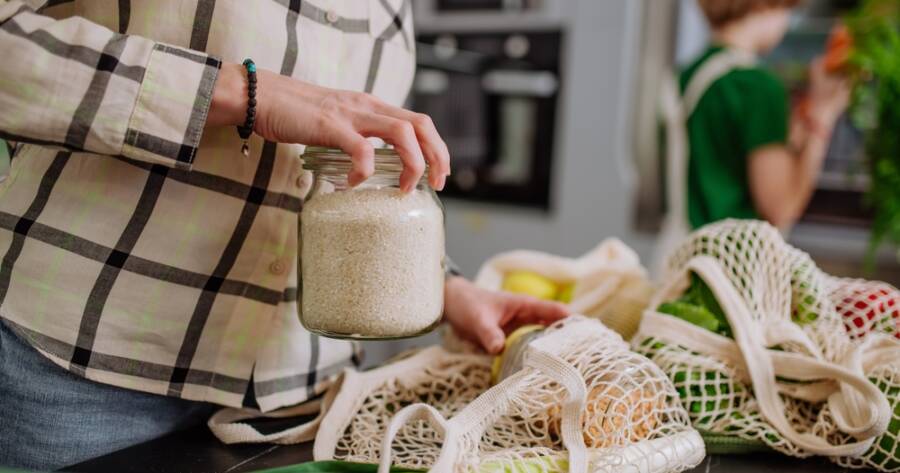A more sustainable lifestyle often starts right at home, with small changes that add up to a big difference. Swapping out everyday disposables for reusable, eco-conscious alternatives reduces waste without sacrificing convenience. With the right essentials in each room, your home can become a cleaner, greener space that supports both the planet and your long-term habits.
Kitchen: Reusable Food Storage and Low-Waste Tools
Plastic wrap and single-use sandwich bags create an endless stream of trash. Reusable silicone snack bags, beeswax wraps, and stainless steel containers offer a practical and eco-friendly solution. These alternatives keep food fresh while cutting down on plastic waste, and most are dishwasher safe for easy cleaning. Glass storage containers are also ideal for leftovers, meal prep, and bulk dry goods.
Swap paper towels for washable cloth napkins and use compostable sponges made from natural fibers. A countertop compost bin helps divert kitchen scraps from landfills, turning waste into nutrient-rich material for plants or garden donations. Every sustainable swap in the kitchen saves resources, lowers your carbon footprint, and encourages more thoughtful consumption with every meal.
Bathroom: Thoughtful Swaps for Daily Routines
Many bathroom staples—like plastic toothbrushes, floss, and disposable razors—end up in landfills. Bamboo toothbrushes are a simple and compostable alternative, and silk dental floss packaged in glass containers can replace plastic spools. Safety razors with recyclable blades last for years, reducing the need for plastic cartridges.
Choose refillable shampoo and conditioner bottles, or opt for solid bars with compostable paper wrapping. Swap liquid soap for bar soap to reduce plastic waste, and replace synthetic loofahs with natural scrubbers made from hemp or coconut fibers. These bathroom changes are gentle on both your body and the planet, creating a self-care routine that aligns with sustainable living.
Laundry Room: Low-Waste Cleaning Solutions
Conventional laundry products often come in bulky plastic jugs and contain harsh chemicals. Switching to laundry detergent sheets or powder in recyclable packaging reduces both waste and water usage. Wool dryer balls eliminate the need for single-use dryer sheets, cutting static and drying time without synthetic fragrance.
Reusable microfiber cloths and natural-bristle brushes are ideal for cleaning around the home, replacing paper towels and plastic sponges. Look for refillable or concentrated multi-purpose cleaners in glass bottles to avoid tossing out plastic spray bottles every few weeks. A zero-waste laundry room doesn’t just protect the environment—it supports a healthier home free from unnecessary toxins and clutter.
Closet: Sustainable Clothing and Reusable Accessories
Fast fashion creates significant waste, but curating a wardrobe with quality, long-lasting pieces can shift your impact. Choose natural fabrics like organic cotton, linen, or hemp, and avoid polyester blends that shed microplastics in the wash. Buying secondhand or supporting brands with transparent supply chains further reduces the footprint of your clothing choices.
Reusable tote bags, cloth produce bags, and stainless steel water bottles are small additions that reduce reliance on single-use plastic when you’re on the go. Repairing clothing instead of discarding it extends its lifespan, while donating or swapping garments keeps textiles out of landfills. A more sustainable closet starts with intention and ends with long-term value.
Living Room: Eco-Friendly Decor and Energy Efficiency
The living room often contains overlooked waste sources, from electronics to decor. Opt for secondhand furniture or invest in sustainably made items crafted from reclaimed wood or recycled materials. Avoid synthetic rugs and upholstery when possible, and choose natural options like wool, jute, or organic cotton for both comfort and sustainability.
Incorporate energy-saving practices by using LED bulbs, unplugging electronics when not in use, and installing power strips to reduce phantom power draw. Houseplants not only purify the air but also encourage mindfulness about the indoor environment. The goal isn’t perfection—it’s creating a space that feels good and does good, one item and one habit at a time.
A Home That Supports Your Values
Shifting to a zero-waste lifestyle doesn’t happen overnight, but each thoughtful upgrade makes a real impact. When every room in your home reflects sustainability—whether through reusable kitchen containers, bamboo bathroom essentials, or eco-conscious decor—you create a space that supports both the planet and your well-being. Sustainable living becomes second nature, and small daily actions evolve into meaningful, lasting change.
